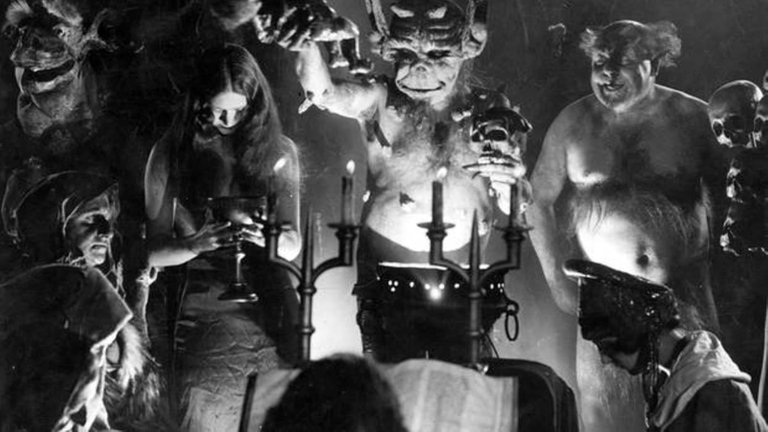Film Review: Häxan (The Witches, 1922)

In the first decades of cinema its forms weren’t properly defined. This resulted in many of the great or important films looking like strange hybrids from today’s perspective. One of the best known among such oddities is The Witches, 1922 Swedish film directed by Benjamin Christensen (also known under its original title Häxan), which is considered both as genuine horror film and historic documentary.
As the title suggests, the subject of the film is witchcraft, or, to be more precise, belief in witchcraft and the way it shaped society during Middle Ages. Häxan is roughly divided into seven chapters. The first chapter, which uses mostly intertitles, stationary images and occasional animation, illustrates lack of scientific knowledge among primitive societies and early civilisations, concluding in medieval concepts of Heaven and Hell. Second chapter introduces live action segments and series of vignettes that illustrate medieval superstitions and beliefs in witches. Next three chapter have more coherent plot set in 1488 and tell a story how man called Jesper suddenly falls ill and dies after which his wife Anna (played by Astrid Holm) is convinced that this was due to a curse by poor old woman named Maria (played by Maren Pedersen); she reports her to Inquisition who arrest Maria, have her tortured and make fantastic confessions about being not only witch, but also part of the coven that includes Anna who is subsequently arrested, tricked into making confession and ultimately condemned to burn at stake. Sixth chapter display various instruments and methods of torture that explain why so many people confessed being witches. Final segment is set in present day and explains that the phenomenon of witchcraft is a product of mental illness, namely hysteria.
Häxan was the third feature film in the career of Benjamin Christensen, Danish director who, until that time had worked mostly at stage, but whose two previous features - spy melodrama Mysterious X and crime melodrama Blind Justice - are considered one of the more innovative works of 1910 Danish cinema. Inspiration for his next project was Malleus Maleficarum, 1486 treatise by Catholic Church inquisitor Heinrich Kramer, a book notorious for spreading beliefs about witches in next few centuries and serving as a manual for witch hunters. After reading the book Christensen has spent almost two years researching historical accounts, as well as contemporary reinterpretations of witchcraft and witch hunts. He ultimately managed to secure funds by famous Swedish studio Svensk Filmindustri, which amounted to 2.2 million Swedish kronas, making it the most expensive silent film in history of Scandinavian cinema. Film was, however, made in Christensen’s old Danish studio, with director insisting on shooting at night (which was quite unusual for the silent era) in order to help the actors get in the proper mood.
Christensen, who also played the character of Devil in the film, clearly shows that the budget was well-spent. Medieval world was reconstructed economically and efficiently. Even the primitive special effects that illustrate beliefs of witches flying are quite convincing for early 1920s technical standards. But the audience was probably more impressed with the way Christensen has mixed documentary segment, represented by his commentary in intertitles, with the often playful and exploitative depictions of the witches’ activities and their bizarre practices. Häxan has couple of disturbing segments, but for some in the 1920s audience more troubling was nudity, which, although tasteful for our standards, led to censorship issues in many countries. The film was also censored in some countries for its anti-clerical stance, seen in scenes when Church inquisitors are portrayed as sadistic manipulators. Film expresses great sympathy for the victims of witch hunts, here represented in the character of old woman, played by Maren Pedersen, elderly vendor Christensen had noticed on the street before the production; she plays her role much more naturally than the professional cast, which sometimes goes into overacting typical of the silent era. Strange mix of live action and author’s commentary creates an effect that won’t be repeated until 1960s and 1970s “Mondo films”.
Häxan was a big hit and received mostly positive reviews. That was enough for Christensen to continue his career in Germany and, later, in Hollywood, but it was cut short by arrival of sound films, forcing him to return to his native Denmark where he never repeated his early successes. In the meantime, his work was recognised as important and influential by many critics and film scholars. Like many silent films, there are various versions. The best known was released in 1968 USA under title of Witchcraft Thorught the Ages, much shortened and accompanied by narration of counterculture icon William S. Burroughs and jazz score by Daniel Humar. Swedish Film Institute restored the original version in 1976.
RATING: 7/10 (+++)
Blog in Croatian https://draxblog.com
Blog in English https://draxreview.wordpress.com/
Leofinance blog https://leofinance.io/@drax.leo
Cent profile https://beta.cent.co/@drax
Minds profile https://www.minds.com/drax_rp_nc
Uptrennd profile https://www.uptrennd.com/user/MTYzNA
Unstoppable Domains: https://unstoppabledomains.com/?ref=3fc23fc42c1b417
Hiveonboard: https://hiveonboard.com?ref=drax
Bitcoin Lightning HIVE donations: https://v4v.app/v1/lnurlp/qrcode/drax
Rising Star game: https://www.risingstargame.com?referrer=drax
1Inch: https://1inch.exchange/#/r/0x83823d8CCB74F828148258BB4457642124b1328e
BTC donations: 1EWxiMiP6iiG9rger3NuUSd6HByaxQWafG
ETH donations: 0xB305F144323b99e6f8b1d66f5D7DE78B498C32A7

I wonder what the belief in witches would be like...
Hahaha